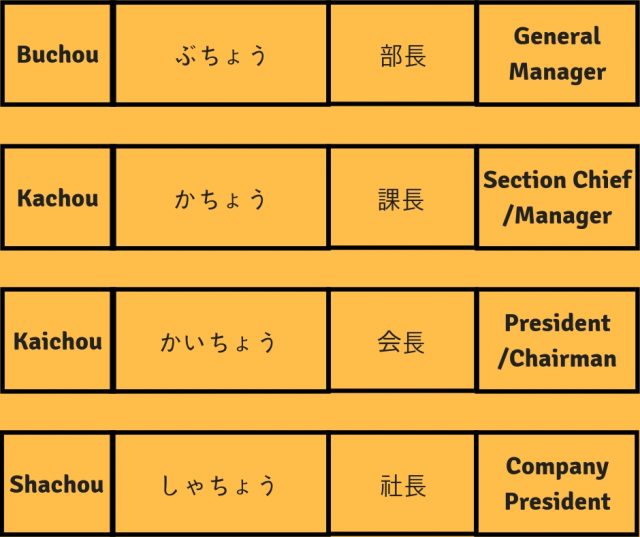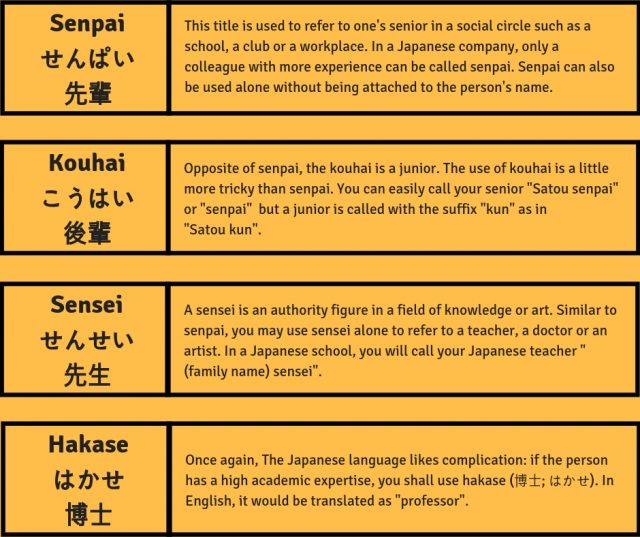What Does San Chan And Kun Senpai Sama Mean In Anime

Last Updated on 03.06.2022 by Coto Japanese Language Schoolhouse
If you have heard san, sama, kun and chan before, and so you lot know that in Japan, you lot but just exercise not phone call people by their names! Or you lot would exist very rude. Indeed, to address someone or speak about someone, you need to use the "Japanese honorific title". To navigate Japanese gild smoothly, you should better sympathise how important it is to properly use them. Let's classify the almost oftentimes used honorific titles such as san, sama, kun and chan…
Curious nigh how to say "you" in Japanese too? Avoid calling your boss "darling" and cheque out our guide on how to address other people in Nihon (as well anata, of course)!
Using Japanese Honorific Titles (Due east.g. San, Sama, Kun and Chan)
In Nippon, most of the time people call each other by their family name rather than their given names. A Japanese honorific title is a suffix that goes after the person's name as in "Satou (proper noun) san (honorific)" to heighten this person upwards.
In doubtfulness, better stay safety and go with the person's family name. Yous will use the suffix when referring to your interlocutor or to someone else in your conversation. As yous may know, Japanese guild values hierarchy and someone of higher status may driblet the honorific title.
San, the most common 1, could be translated as "Mr.", "Mrs." and "Ms." and is gender neutral. Notwithstanding, you will find that Japanese honorific titles are more complicated to use than it looks and that they cannot be then hands translated.
Japanese Honorifics In the Workplace
Beware of the Japanese working surroundings! In traditional Japanese companies and workplaces, instead of honorific titles, Japanese workers can be addressed past their work titles. Instead of saying Tanaka san", you lot would say "Tanaka shacho" to speak almost your company president. Bank check out our Business Japanese Courses if you are interested in learning business organization Japanese!
Contents:
- Using Japanese Honorific Titles (E.thousand. San, Sama, Kun and Chan)
- San (さん), Sama (さま), Kun (くん) and Chan (ちゃん)
- Concept of 呼び捨て (Yobisute)
- Other Japanese Honorific Titles

San (さん)
San is certainly the kickoff honorific title yous will larn when studying Japanese or going to Nihon. The usage of san is very wide: the suffix tin can be added to a person's characteristic and entities such as a visitor. For example, a bakery could be called by "pan ya san" (literally Mr bread shop).
Sama (さま)
Sama is the respectful version of san, generally used in business organisation and clientele context. This is since the unsaid superiority of the guest or customer is very strong. When you send a letter, the recipient's proper name will be followed by the kanji "様". In gild to address a group of persons or an audition with respect, sama is attached to "mina" (everyone). This title is also a part of several set of phrases such as "ostukaresama" or "omachidou sama".Yous easily understand why the Japanese deities are referred to as "kami sama". Formal Japanese can be confusing and complex, please accept a await at our guide on Japanese Keigo ( Formal Japanese) to larn the proper way of speaking in formal Japanese
Kun (くん)
The informal kun (君) is strictly reserved to young men or juniors although, in a business context, young women can be chosen "kun" past their superior. Once again, you lot should ever keep in heed the implied hierarchy of a title. Kun is used by a person of a higher status towards a younger male person or a child. Friends can also refer to each other by kun in a casual context and women can utilize it to address a man to whom they are very shut.
Chan (ちゃん)
Chan, the kittenish version of san, refers to children and girls. The change from "s" sound to "ch" is considered cute in Japanese. Similar for kun, friends and lovers can also accost each other with this honorific. Surprisingly, at that place are some strange and wonderful exception to chan, as it tin can be used to refer to an endearing adult. Among the most famous examples, you will find Arnold Schwarzenegger, called Shuwa chan. Fun fact! Chan is likewise oft used to refer to cute animals and in particular, cats!
One common error Japanese learners brand is referring to themselves with an honorific title. Retrieve to never use san or any other title to refer to yourself unless you want to sound arrogant! The only exception to the rule is chan: in a coincidental context, some people, in particular, women, will refer to themselves in a kittenish third person.
Concept of 呼び捨て (Yobisute)
Yobisute (呼び捨て) is the deed of dropping the suffix when yous refer to someone else. As it shows a degree intimacy, it is important to take a peek into the Japanese concept of "in-out" (uchi / soto) ruling the whole Japanese voice communication.
- In Japanese, "uchi" ways home. As a concept, "uchi" refers to all the people you know inside a specific social circle: your family, your company, your club. For example, inside the "uchi", family members may drop the title.
- In Japanese, "soto" ways outside. Equally a concept, "soto" refers to all the people who are not inside your specific social circle. For case, some other visitor's employee.
Japanese speech differs depending on the social context of your interlocutor. Foreigners near often struggle to grasp the honorific spoken language and the profoundly complex politeness of Japanese language. An important and simple rule is that you will not speak the same way with someone from "uchi" to someone from "soto". Regarding the honorific championship, the catchy conversation context would exist when your interlocutor is from soto and you are referring to someone from "uchi":
- You are talking with a client about your manager, Mr. Kaneki. In your function, you lot ordinarily refer to your primary as Kaneki san. But in this context, y'all will drop the honorific title and apply the work title: buchou no Kaneki. If you lot are talking about a colleague, for case, Takezawa san, y'all will use the word colleague instead of the honorific san: douryou no Takezawa. Note that in such state of affairs, the work title should come commencement and be attached with the particule "no" to the proper noun.
Other Japanese Honorific Titles
Are in that location other Japanese honorific titles?
By now, you must take guessed there is quite a long list of honorific titles. The most famous ones are definitely senpai, kouhai and sensei.

Other titles exist, such as "bou" (坊) for very immature boys and the formal "shi" (氏) most exclusively used by writing and in particular for legal and academic documents. Historically, samouraï and lords were respected with the championship dono read as "tono" (殿) simply nowadays, y'all may see this title only in official documents and certificates. If you enjoy learning about Japanese history, y'all might too have heard "chichi ue" or "haha ue" to speak about one'due south father (chichi) or female parent (haha) with a loftier level of respect: 上 (ue) meaning above.
As for Foreigners…
What about foreigners?
Very often, foreigners feel confused and surprised to hear people addressing others with their family name. Japanese are not always at ease when addressing a foreigner but they know the connection unsaid by the use of the outset proper name away. Do not be surprised if "san" is added to your offset proper name instead of your family name. And practice not feel offended if they omit the "san" every bit some Japanese might attempt to respect westerner manners.
On the contrary, the employ of the first proper name is considered too familiar for Japanese and they would feel rather uncomfortable. That being said, the more than you spend time in Japan or close to Japanese, the more you volition understand exceptions exist, in item with Japanese who have experience with foreigners.
In concern contexts, it is necessary to use keigo with colleagues of college positions and seniority. Discover out more hither.
Yous can besides learn about the different means to refer to yourself here
Let'southward picket a video to recap on what you have learned
Latest Animated Version is here!
Looking to learn more Fun & Like shooting fish in a barrel Japanese? – please read Nihongo Fun & Easy – written past Teachers from Coto Japanese Academy

Take lessons to learn how to refer to yourself. Make full out our contact class to become started.
Source: https://cotoacademy.com/san-sama-kun-and-chan/
Posted by: martindanythe.blogspot.com

0 Response to "What Does San Chan And Kun Senpai Sama Mean In Anime"
Post a Comment